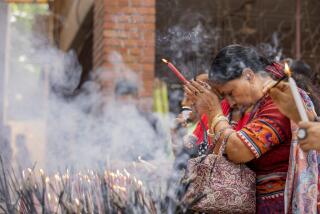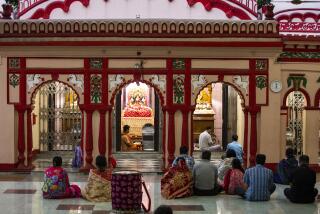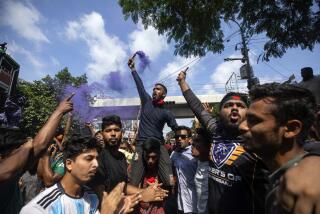200 Die as Riots Erupt Across India : Religion: Hindu destruction of a Muslim temple triggers carnage. Government appears in disarray as troops seek to restore order.
- Share via
NEW DELHI — In a holy war that threatened to engulf South Asia, more than 200 people were killed and hundreds injured Monday as bloody religious riots erupted in cities and towns across India and communal tensions flared from the frenzied destruction by Hindu militants of a revered Muslim temple in Ayodhya.
Scores also were wounded in violent anti-Hindu demonstrations in half a dozen cities in Bangladesh and Pakistan, neighboring Muslim countries, while other clashes and peaceful protests were reported in Iran, Sri Lanka and Dubai.
The day’s religious carnage appeared to be among the worst that India has suffered since independence and partition 45 years ago. A Cabinet official here said it posed the gravest threat to India’s secularism since Mohandas K. (Mahatma) Gandhi, father of modern India, was assassinated in 1948 by a Hindu fanatic opposed to his campaign for nonviolence against Muslims.
But other officials said that the riots are likely to subside in several days as heavily armed military troops restore order.
Prime Minister P. V. Narasimha Rao’s minority government appeared in sharp disarray as calls increased for him to resign. Rao was shouted down twice in the lower house of Parliament and was unable to speak in the pandemonium. Opponents called for a national strike today to protest the government’s failure to protect the Babri mosque in Ayodhya and to keep religious peace.
Late Monday, the government moved to ban fundamentalist groups, and by early today, security forces had driven thousands of Hindus from the area of the destroyed mosque and retaken the temple grounds.
The always fragile religious tolerance in the world’s second-most- populous nation appeared to disintegrate in city after city as mobs of Hindus battled with Muslims, who form about 12% of the country’s 860 million people. Rarely have religious riots here spread so far so fast.
Many of the victims were killed when police opened fire on rampaging mobs that attacked temples, cars and homes.
The death toll was reported highest in Bombay, the country’s business and commercial capital, where at least 40 people were killed in pitched battles with police after youths torched a police van and several buses and stoned commuter trains. Heavily armed army troops were called out in the tense city.
Strict curfews were ordered in dozens of cities and districts in 10 states with large Muslim populations, according to Indian news agencies. Parts of Calcutta were under curfew after large-scale arson, rioting and attacks on Hindu temples, police said.
A curfew also was imposed in New Delhi’s walled Old City, where police fired over the heads of crowds attacking vehicles and in a crowded Muslim quarter of east New Delhi.
The 464-year-old Ayodhya mosque was overrun Sunday and demolished, brick by brick, by a charging mob of right-wing extremist Hindus who insist, with little or no evidence, that it stands on the birthplace of fabled Hindu warrior-king and demigod Lord Rama.
More than 200,000 Hindu devotees had gathered around the ancient mosque Sunday, supposedly for a peaceful ceremony to consecrate construction of a Hindu temple outside the mosque, a compromise the government had hoped would defuse any confrontation.
Instead, tens of thousands of shrieking Hindus stormed the three-domed, red-brick-and-plaster structure in what appeared to be a planned attack; they demolished it in five hours with pickaxes, hammers and often bare hands as state police fled the site and watched silently from nearby.
An Indian photographer who slipped early Monday into Ayodhya, where scores of journalists had been assaulted the day before, said the fanatic kar sevaks, or Hindu holy workers, already had put up bamboo scaffolding over the rubble and were beginning to build their temple. Saffron flags waved from the scaffolding, he said, and the workers sang hymns and chanted prayers as they carried bricks and construction material to the site before they were routed by security forces.
The government announced late Monday that it would try to rebuild the demolished mosque.
Muslim leaders appealed for calm, fearing further violence. Armed troops surrounded the main Jama Masjid mosque in New Delhi, where the nation’s most powerful imam, Syed Abullah Bukhari, called the Ayodhya attack “unbearable” but urged restraint.
In Lucknow, capital of Uttar Pradesh state where Ayodhya is located and a curfew was in force, eight trucks full of army troops with assault rifles patrolled slowly past shuttered shops on deserted streets. Cows walked unhindered, dogs slept in the road and crows cawed loudly in the eerie silence.
“There is a panic among the people,” said a city magistrate, Ram Satyen, who accompanied the camouflage-clad troops.
Black mourning flags fluttered from rooftops in Muslim areas, where two people were reported killed Sunday.
“It’s death for Indian secularism,” said Mohammed Sabir Ali Rizvi, a bearded 25-year-old student wearing a Muslim prayer cap, standing in a doorway. “It’s death of the rule of law.”
Several blocks away, by an ornate four-story Muslim gate, another student, Asghar Mehdi, complained that the city’s mostly Hindu police offered Muslims no protection. “We are feeling insecure, totally insecure,” he said.
Lal Krishna Advani, the fiery leader of the ultranationalist Hindu party that used the temple dispute to become the country’s second-largest party and chief political opposition last year, resigned from Parliament. He was arrested, along with two political allies, early today under a law against fostering “communal disharmony,” according to news reports.
It wasn’t immediately clear if his fundamentalist Hindu party would gain from the crisis or alienate more moderate supporters and discredit the grass-roots Hindu revivalist wave that has swept the country and is now tearing it apart.
Virtually every national newspaper expressed outrage at the mosque’s destruction. The Pioneer said the attack “will go down as the darkest day of Indian history.” The Hindu, another national daily, said that “religious fanaticism at its ugliest” had “delivered a lethal blow to the image of a secular and democratic India.”
Advani, who watched the mosque’s razing Sunday, appealed in vain for the mob to stop but was forced off the podium by more militant Hindu clerics who seized his microphone to encourage the attackers and praise the destruction.
At least 17 people were reported killed in Jaipur, popular with tourists for its graceful pink palaces and proximity to the famed Taj Mahal. Others were killed in Ahmedabad, capital of Gujarat state, which has a grim history of Hindu-Muslim violence.
A curfew was imposed in the central Indian city of Bhopal, where enraged Muslims reportedly set fire to at least three Hindu temples. Rioting also was reported in the southern city of Hyderabad, in the eastern state of Bihar and in the southern states of Karnataka and Kerala.
In Pakistan, angry Muslims attacked more than 30 Hindu temples across the country, and the government ordered offices and schools to close for a day to protest the mosque destruction, the British news agency Reuters reported.
Reuters said that in the ancient city of Lahore, thousands of people used a bulldozer to demolish an abandoned Hindu temple, set fire to six other old temples and stormed the offices of Air-India.
JOURNALIST’S NIGHTMARE: Correspondents were targets of Hindu mob. World Report
More to Read
Sign up for Essential California
The most important California stories and recommendations in your inbox every morning.
You may occasionally receive promotional content from the Los Angeles Times.











